Imperial porcelain and works of art made for the Qing court to be offered at Bonhams Hong Kong
HONG KONG - The forthcoming Fine Chinese Ceramics and Works of Art sale, to be held on 3 December 2015 at Bonhams Hong Kong, will offer a curated sale of fine and rare porcelain and works of art made for the Qing Court, which would have once graced the Imperial palaces.
An exceptionally rare Imperial celadon-glazed olive-shaped vase, Yongzheng seal mark and of the period (1723-1735), is estimated at HK$ 3,000,000 – 5,000,000. It is an outstanding example of innovation and remarkable technical perfection achieved in the Imperial kilns during the Yongzheng period, and no other identical example appears to have been published.
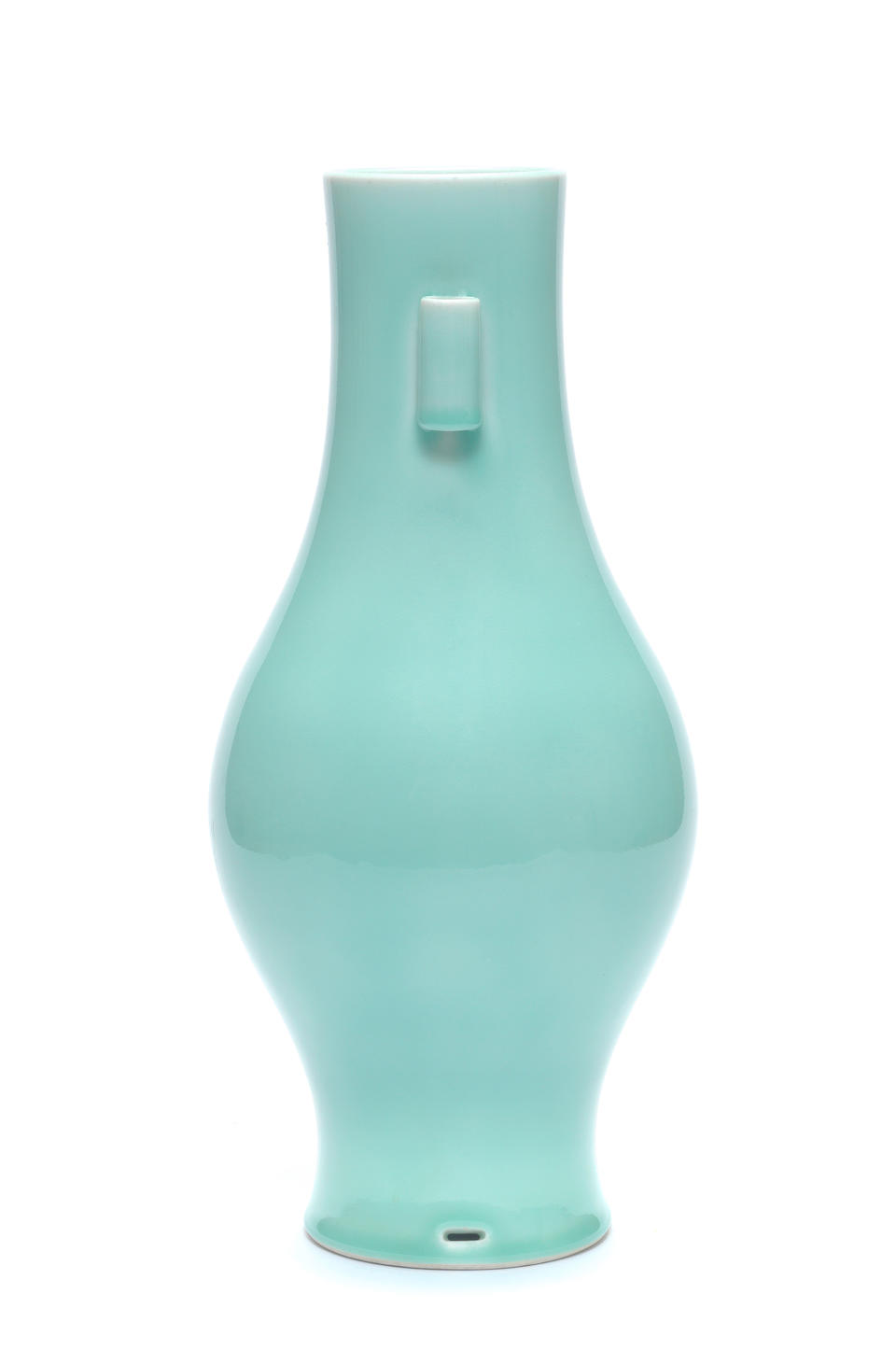
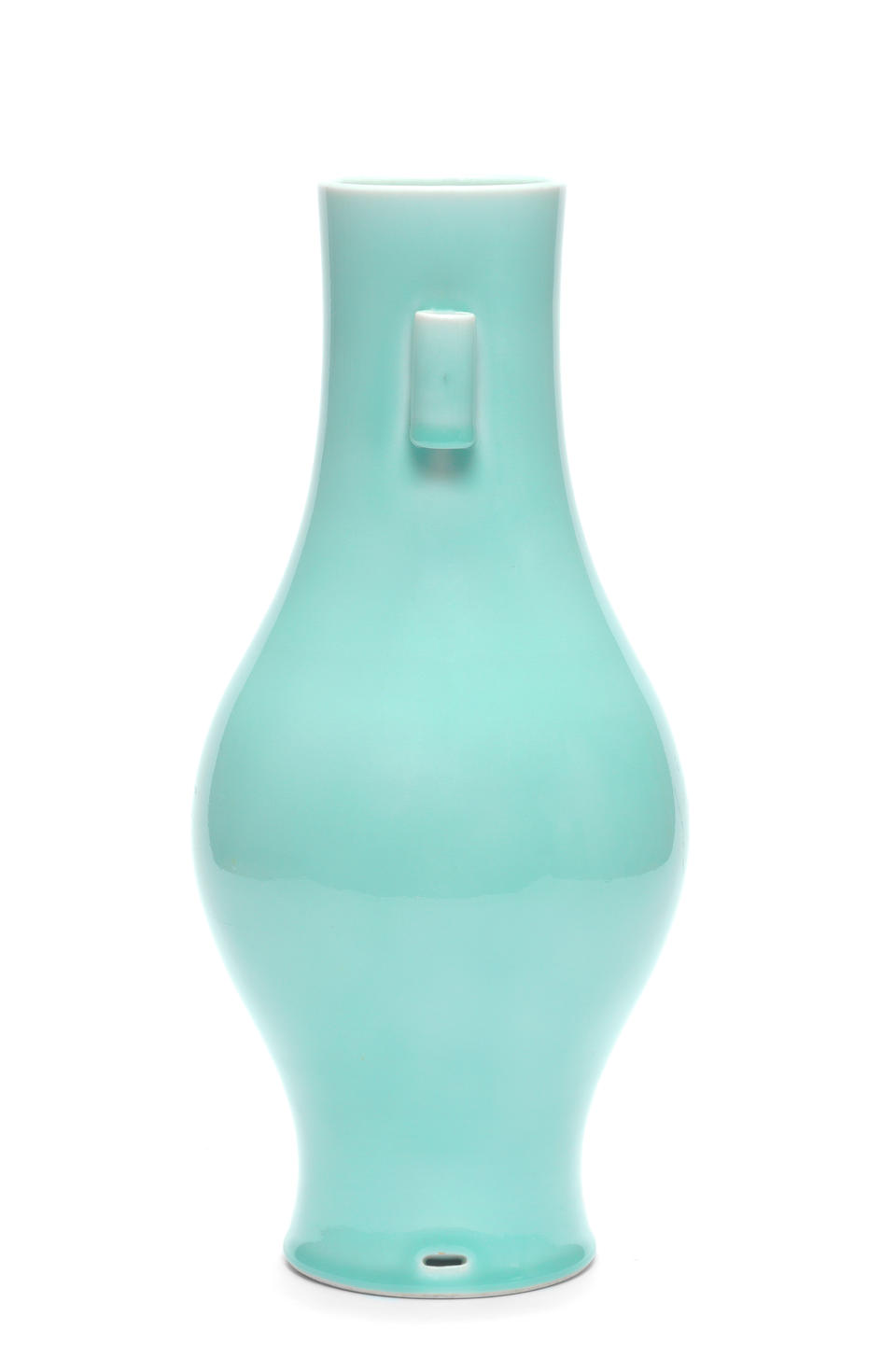
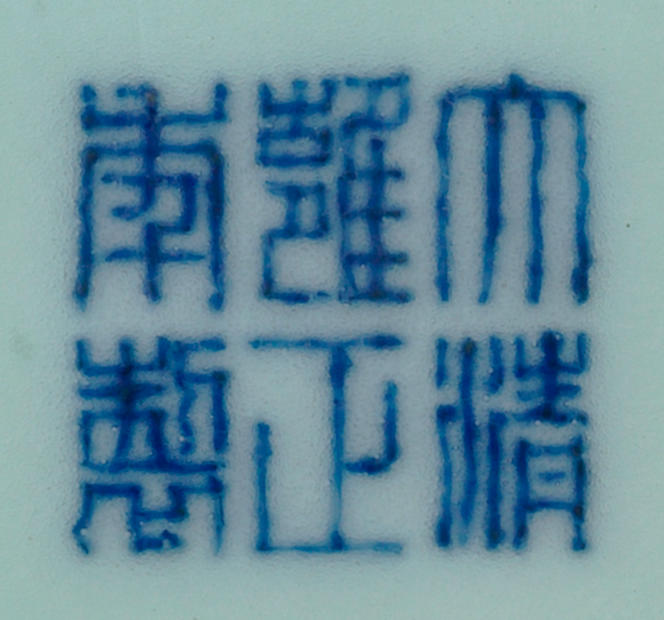
Lot 22. An exceptionally rare Imperial celadon-glazed olive-shaped vase, Yongzheng seal mark and of the period. Estimate HK$ 3,000,000 - 5 ,000,000 (€350,000 - 590,000). Sold for HK$ 17,320,000 (€ 2,057,715). Photo Bonhams
Elegantly potted with a gently rounded body, tapering towards a slightly spreading foot flanked by two apertures, rising to the neck applied with a pair of short tubular handles, covered with a delicate pale green glaze. 42.5cm (16 3/4) high
Provenance: A British private collection; acquired by the grandfather of the present owner, and thence by descent
Notes: The present vase is an outstanding example of the innovation and remarkable technical perfection achieved by craftsmen working at the imperial kilns in Jingdezen during the Yongzheng period.
It is exceptionally rare to find monochrome vases of olive-stone form decorated with a celadon glaze. It is even rarer for such form to be accompanied by tubular-handles flanking the neck, enhancing its elegant proportions. The large size of the vase is noteworthy, further emphasising the remarkable form, and making this vase a particularly challenging technical feat. The successful firing of the graceful tall shape combined with the jade-like luminous tone of the celadon glaze, makes this vase truly astounding to behold.
The particular combination of short tubular handles on this vase form is recorded as a Yongzheng period innovation by Geng Baochang, see Ming qing ciqi jianding, Hong Kong, 1993, p.234, fig.10. Culture and art during the Yongzheng emperor's rule featured tradition and innovation, inheriting from the past and setting the stage for the future. The refined quality, as well exemplified in the present vase, demonstrates the Yongzheng emperor's imperial taste and artistic style. This is manifested in the graceful form, combined with archaistic elements such as the tubular-handles and apertures at the foot, which may be seen on Western Zhou dynasty bronzes and Song dynasty vases, or the jade-like quality of the glaze, reminiscent of the finest Longquan wares of the Northern Song dynasty.
See for example the slender bronze hu vase, Western Zhou period, illustrated in Zhongguo Wenwu Jinghua Dacidian: Qingtong juan, Shanghai, 1995, p.134, no.464. See also the tubular handles and green glaze on a Longquan vase, Song dynasty, and the apertures on the foot of a guan bow-string vase, Southern Song dynasty, both from the Qing Court collection, illustrated in The Complete Collection of Treasures of the Palace Museum: Porcelain of the Song Dynasty (II), Hong Kong, 2001, pls.1 and 102.
The body of the current vase is however, more comparable to the classic olive or ganlan shape, where it is much more slender and gracefully tapered to the foot with a flared mouth rim. This vase form was admired in the preceding Kangxi emperor's reign, and continued to be appreciated by the Yongzheng emperor. However, in contrast to the earlier reign's olive-shaped vase, those produced during the Yongzheng period tend to have wider and shorter necks, such as seen on the current lot. A very high level of skill by a master potter would have been required to achieve a successful balanced form, more so with a vase of this tall proportion.
As an eminent and highly discerning connoisseur of art, the Yongzheng emperor demanded the highest level of craftsmanship of all elements of porcelain production. The remarkable even quality of the vase's subtle glaze, a perfection of the delicate, almost watery-toned celadon monochrome porcelains of the Kangxi period, attests to this.
Compare a Yongzheng mark and period coral-ground famille rose vase of similar shape from the Qing Court collection, illustrated in The Complete Collection of Treasures of the Palace Museum: Porcelains with Cloisonné Enamel Decoration and Famille Rose Decoration, Hong Kong, 2009, pl.77. See also another Yongzheng blue and white olive-shaped vase but without handles, illustrated in The Complete Collection of Treasures of the Palace Museum: Blue and White Porcelain with Underglazed Red (III), Hong Kong, 2000, pl.79. Vases of this form continued to be made in the Qianlong period but with a more slender neck and pronounced curve of the body, see a yellow-ground example with green dragons, illustrated in Selected Porcelain of the Flourishing Qing Dynasty at the Palace Museum, Beijing, 1994, pl.85.
A related guan-type vase, Yongzheng mark and period, but of smaller size (31.8cm high), was sold at Sotheby's Hong Kong, 8 October 2013, lot 3128.
Also in the sale is a very rare Imperial guan-type 'fish basket', Qianlong seal mark and of the period (1736-1795), previously part of the renowned collection of J.M. Hu (1991-1995). It is estimated at HK$ 5,000,000 – 7,000,000. Related examples can be found in important museum collections such as the Palace Museum, Beijing and the British Museum, London.
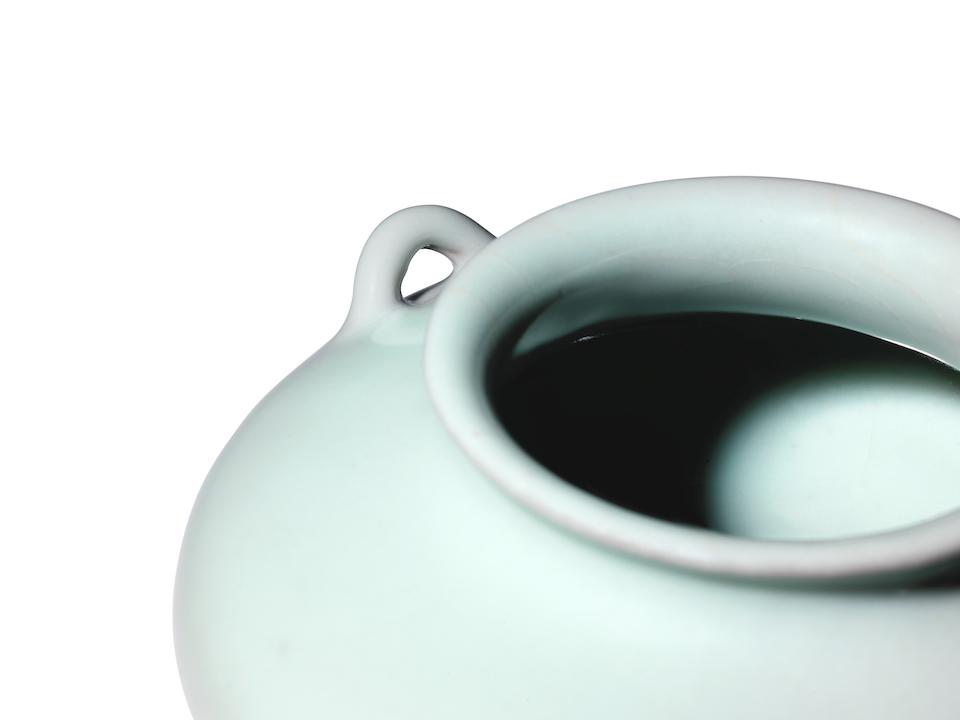
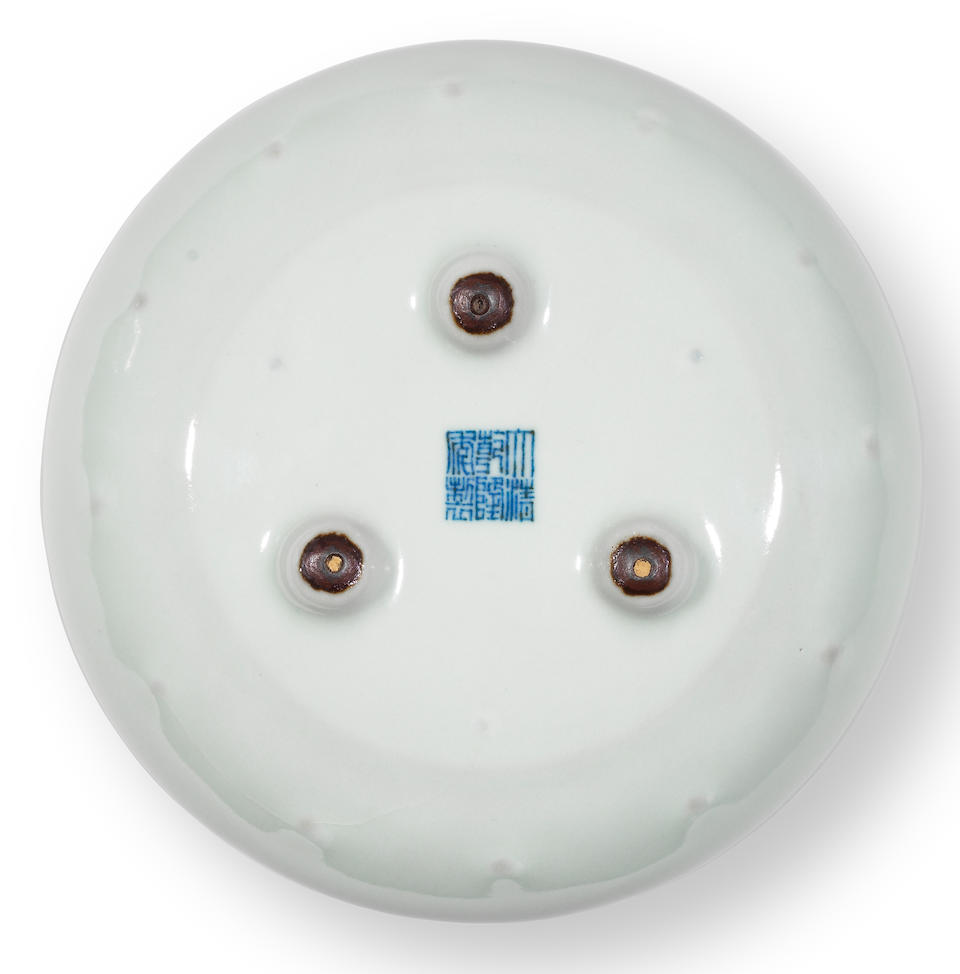
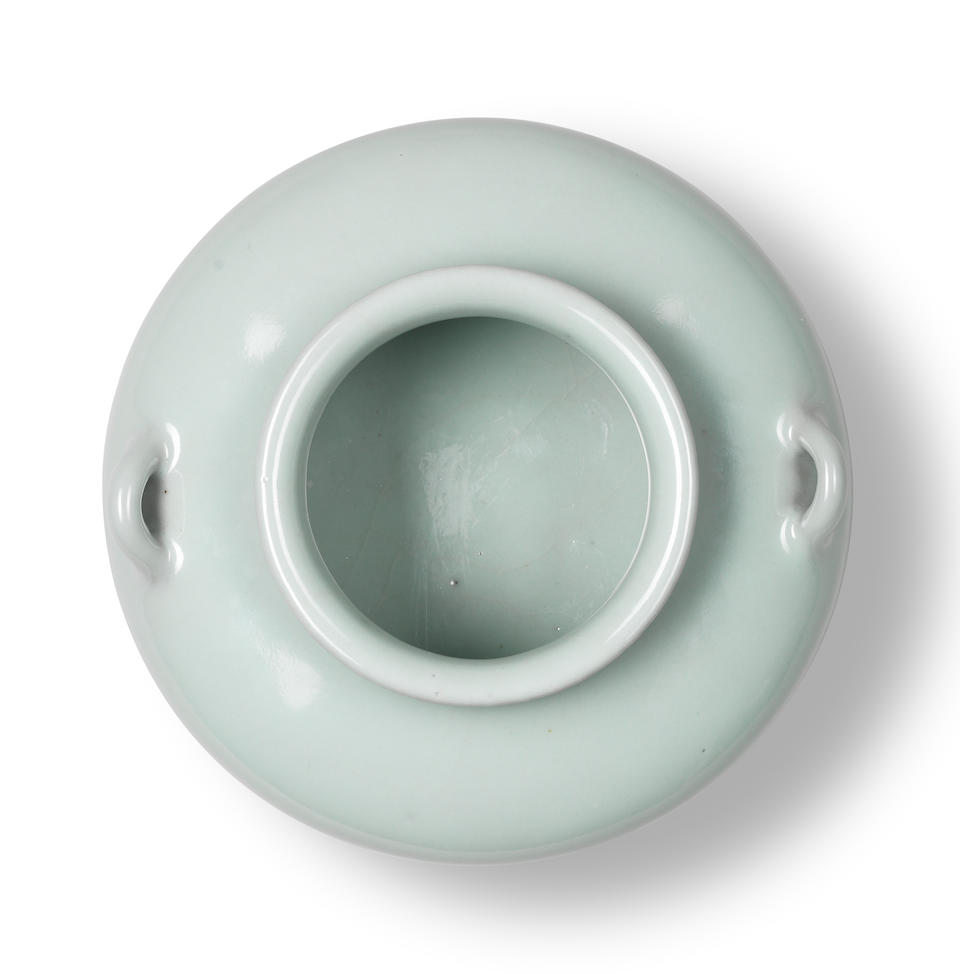
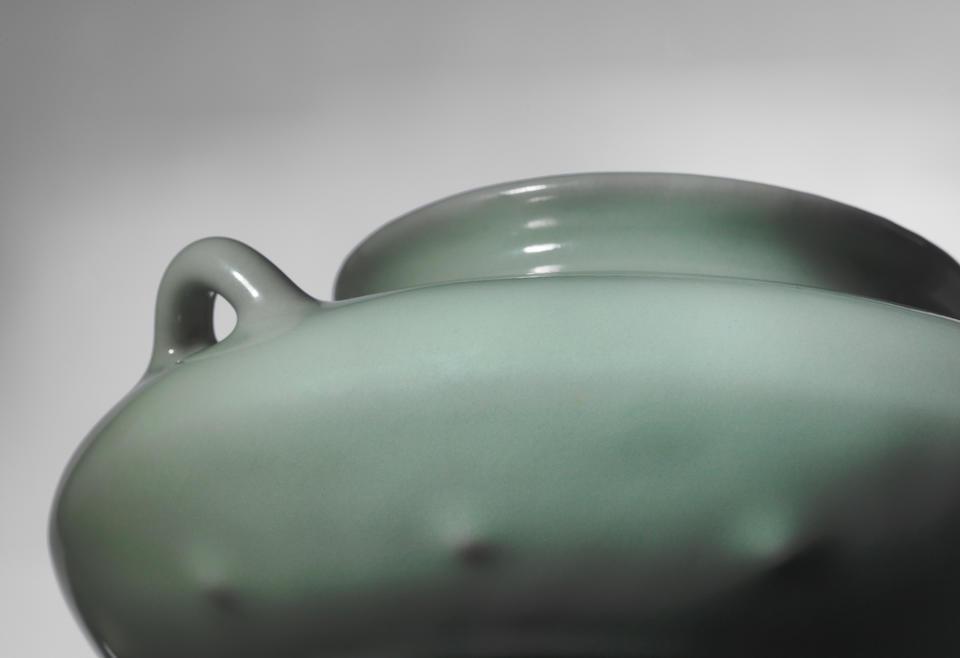
Lot 27. A very rare Imperial guan-type 'fish basket' vessel, Qianlong seal mark and of the period. Estimate HK$ 5,000;000 - 7,000,000 (€590,000 - 820,000). Sold for HK$ 6,040,000 (€ 717,586). Photo Bonhams
The compressed globular body covered in an even pale greyish-celadon glaze, with a pair of small upright loop handles on the shoulder, rising to a short neck and a flared mouthrim, the lower part of the body elegantly decorated with a row of twelve bosses, all raised on three short rounded feet dressed in dark brown. 17.3cm (6 3/4in) wide
Provenance: J.M.Hu Family Collection, sold at Sotheby's New York, Important Chinese Ceramics from the J.M. Hu Family Collection, 4 June 1985, lot 61
Note: The 'fish basket' vessel is an outstanding example of tradition and innovation embraced by the Yongzheng and Qianlong emperors, and brought to fruition through the exceptional skills of the potters in the imperial kilns. Deceptively modest in look, it is a masterful feat of well-balanced form combined with a superbly executed glaze, resulting in an exquisite harmonious work of art.
The earliest examples of this form, referred to as yu lou zun ('fish basket') dated to the Yongzheng period; see a teadust-glazed 'fish basket' vessel, Yongzheng seal mark and period, illustrated by Geng Baochang, Gugong bowuyuan cang qingdai yuyao ciqi, vol.1, part 2, Beijing, 2005, pl.13; and also a guan-type glazed 'fish basket' vessel, Yongzheng seal mark and period, from the collection of Sir Augustus Wollaston Franks in the British Museum, London, museum no.Franks.736. In form the vessel is inspired by Song dynasty incense burners or washers, particularly with regard to the raised studs, such as the one illustrated in The Complete Collection of Treasures of the Palace Museum: Porcelain of the Song Dynasty (II), Hong Kong, 1996, pl.129. The glaze imitates the prized guan glaze produced during the Southern Song dynasty, which alongside other Song dynasty ru and jun glaze were reproduced during the Yongzheng and Qianlong reigns.
Three examples of similar 'fish basket' vessels, Qianlong seal mark and period, in varying glazes are in the Palace Museum, Beijing: the first, with a guan-type glaze, is illustrated in The Complete Collection of Treasures of the Palace Museum: Monochrome Porcelain, Hong Kong, 1999, pl.209; the second, with a ru-type glaze, is illustrated in Ceramics Gallery of the Palace Museum: Part II, Beijing, 2010, pl.381; and the third with a robin's egg glaze, is illustrated by Feng Xianming and Geng Baochang, Selected Porcelain of the Flourishing Qing Dynasty at the Palace Museum, Hong Kong, 1994, p.356, pl.93. See also an example painted with lotus scrolls in underglaze blue, Qianlong seal mark and period, from the Shanghai Museum, illustrated in The Official Kiln Porcelain of the Chinese Qing Dynasty, Shanghai, 2003, p.229.
Several examples are extant in important private collections: two guan-type examples, Qianlong seal mark and period, also from the J.M.Hu collection, are illustrated in Qing Imperial Monochromes The Zande Lou Collection, pp.96-97, pl.31; a further guan-type glazed example, Qianlong seal mark and period, is illustrated by R.Krahl, Chinese Ceramics of the Meiyintang Collection, vol. 2, no.872, and later sold at Sotheby's Hong Kong, 5 October 2011, lot 5.
See also a related Ru-type 'fish basket' vessel, Qianlong seal mark and of the period, also from the J.M.Hu Family Collection, sold at Sotheby's New York, 4 June 1985, lot 60 and later at Sotheby's Hong Kong, 14 November 1989, lot 189, illustrated in Sotheby's Hong Kong, Twenty Years, 1993, p.228, no.323, and Eskenazi Ltd., Qing Porcelain from a Private Collection, London, 2012, pl.11.
A rare Imperial puce-enamelled blue and white 'dragon' moonflask, Qianlong seal mark and of the period (1736-1795), estimated at HK$ 1,500,000 – 2,000,000, was kept in the family for over 100 years, by descent from Colonel W.H. Starr, CB, CMG, CBE, who served in the Royal Army Medical Corps from the 1850s to WWI.


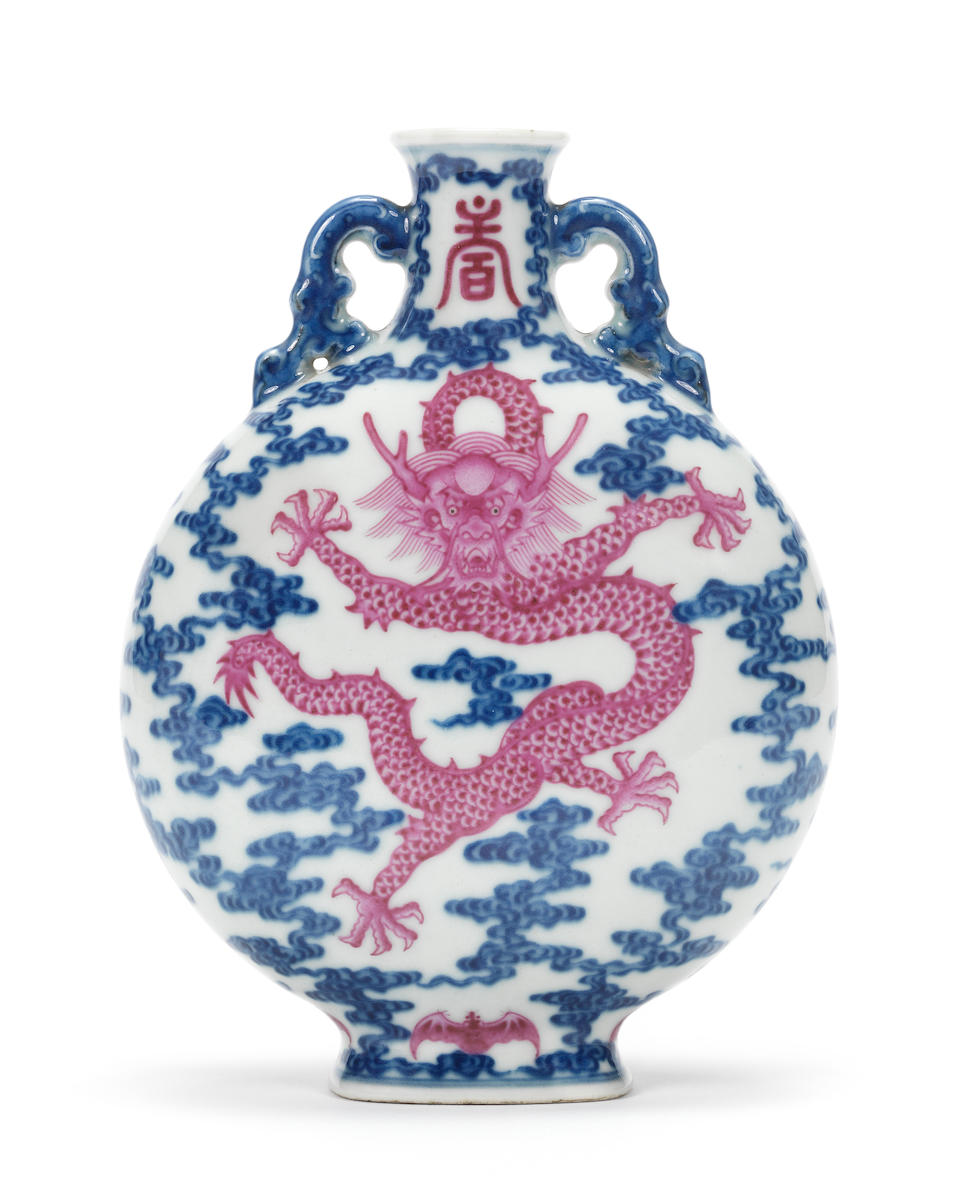
Lot 30. A rare Imperial puce-enamelled blue and white 'dragon' moonflask, bianhu, Qianlong seal mark and of the period (1736-1795); 16.8cm (6 5/8in) high. Estimate HK$ 1.500,000 - 2,000,000 (€180,000 - 230,000). Sold for HK$ 5,680,000 (€ 674,816). Photo Bonhams
With a gently-rounded body raised on a high oblong foot, vibrantly decorated on each side in puce enamel with a ferocious front-facing five-clawed dragon amidst trails of cloud scrolls in underglaze blue, above a small bat and below a shou character, the neck flanked by two elegant scrolling handles.
Provenance: Colonel W. H. Starr, Royal Army Medical Corps, CB, CMG, CBE.
Note: William H. Starr, Colonel with Her Majesty's Royal Army Medical Corps (RAMC), was responsible for providing medical supplies and treatment to all British Armed Forces, military personnel and their families during times of war and peace. Starr was awarded the following medals: the 1854 India General Service Medal with a Waziristan 1894-1895 clasp; the 1900 China Medal, without clasp, probably for service during the Boxer Rebellion; Commander of the Order of the Bath (CB); Commander of the Order of St. Michael and St. George medal; Commander of the Order of the British Empire medal (CBE); 1914 Star; British 1914-1918 War Medal; and the British First World War Victory Medal.
A testament to the exceptional skills employed at the imperial kilns and a superb example of imperial porcelain production at the height of the Qianlong period, this flask exhibits certain characteristics typical of the finest pieces made for the Qianlong emperor. The unusual small and intimate size (16.8cm high), makes this vase a personal piece to be handled and admired. Further, it is very rare to find this style of decoration featuring a dragon in puce enamel surrounded by underglaze blue cloud scrolls.
Compare, however, a number of similar moonflasks, but of larger size: see from the Qing Court collection, illustrated inThe Complete Collection of Treasures of the Palace Museum. Blue and White Porcelain with Underglazed Red (III), Hong Kong, 2000, pl.232 (29cm high); see also an interior view showing a pair of similar moonflasks decorating theCui Yun Guan, the 'Hall of Green Cloud' in the Forbidden City, illustrated in The Complete Collection of Treasures of the Palace Museum: Furniture of the Ming and Qing Dynasties (II), Hong Kong, 2002, pl.261; and compare also a related pair of puce-enamelled blue and white baluster 'dragon' vases, Qianlong marks and period, illustrated inChinese Ceramics in the Idemitsu Collection, Tokyo, 1987, pl.228 (48.9cm high).
The form of the present vase is inspired by early 15th century moonflasks, which in turn were based on Islamic metal forms. The form was re-established as an imperial favourite in the 18th century. This was characteristic of the Qianlong emperor's admiration of past forms and decorative styles, and arguably as a symbolic way of stamping the Qing five-clawed full-front dragon over the Ming dynasty style shaped vase.
Compare also the similar intricate enamelling in puce colour of the dragon on the present moonflask to the phoenixes on a large pink-enamelled blue and white moonflask, Qianlong seal mark and period, formerly in the Shorenstein collection, sold at Christie's Hong Kong, 1 December 2010, lot 2968.
A very similar moonflask (16.8cm high), but with an effaced mark, possibly the pair to the present lot, was sold in our London rooms, 17 May 2012, lot 347.
An exceptional finely-inlaid 'hundred-deer' zitan box and cover, Kangxi (1662-1722), estimated at HK$ 3,500,000 – 4,500,000, published in 1993 and 2003, demonstrates the highest level of workmanship achieved during the early Qing Dynasty. The brilliance of the master craftsman is evident in how naturalistic the scene appears. The multiple deer depicted on the present box elude to the popular 'hundred deer' motif, bailu, which is a homophone for 'hundred emoluments', representing the wish 'May you receive the hundred emoluments from heaven'. Deer were also regarded as symbols of longevity due to their long life spans and ability to find lingzhi, the fungus of immortality. The decoration on the present box, with deer depicted together with pine trees and rocks that are also symbols of longevity, presents a multitude of auspicious wishes.

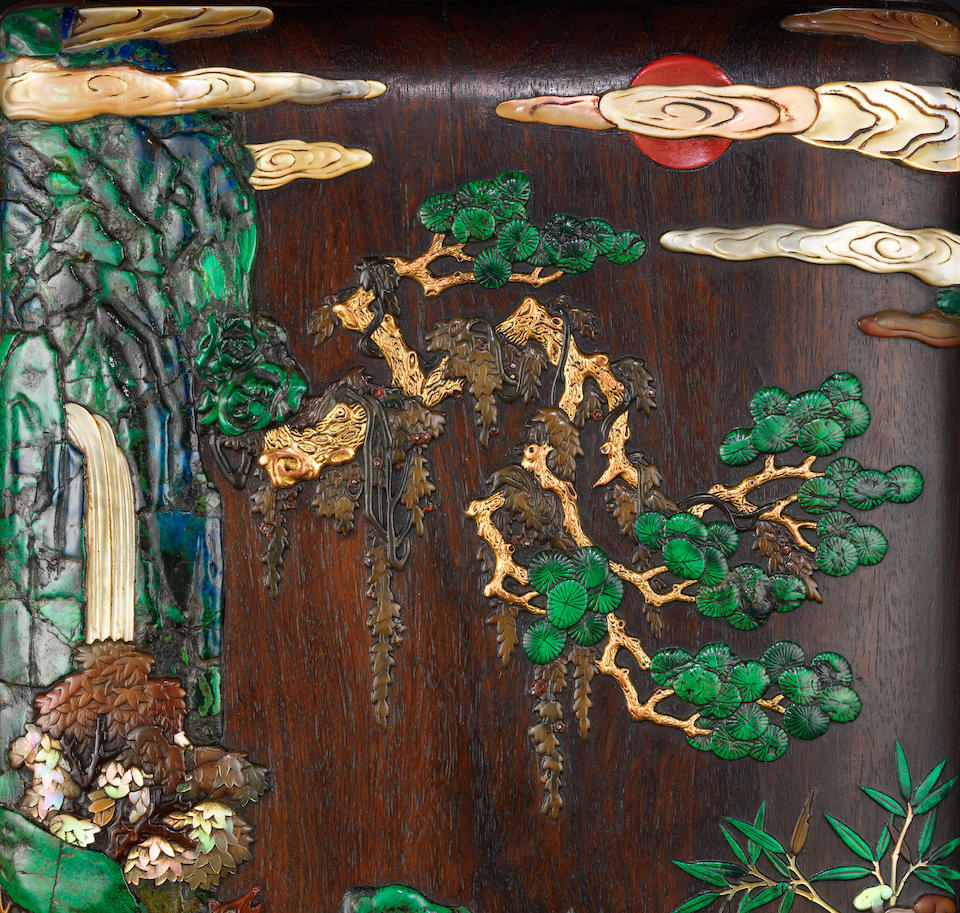
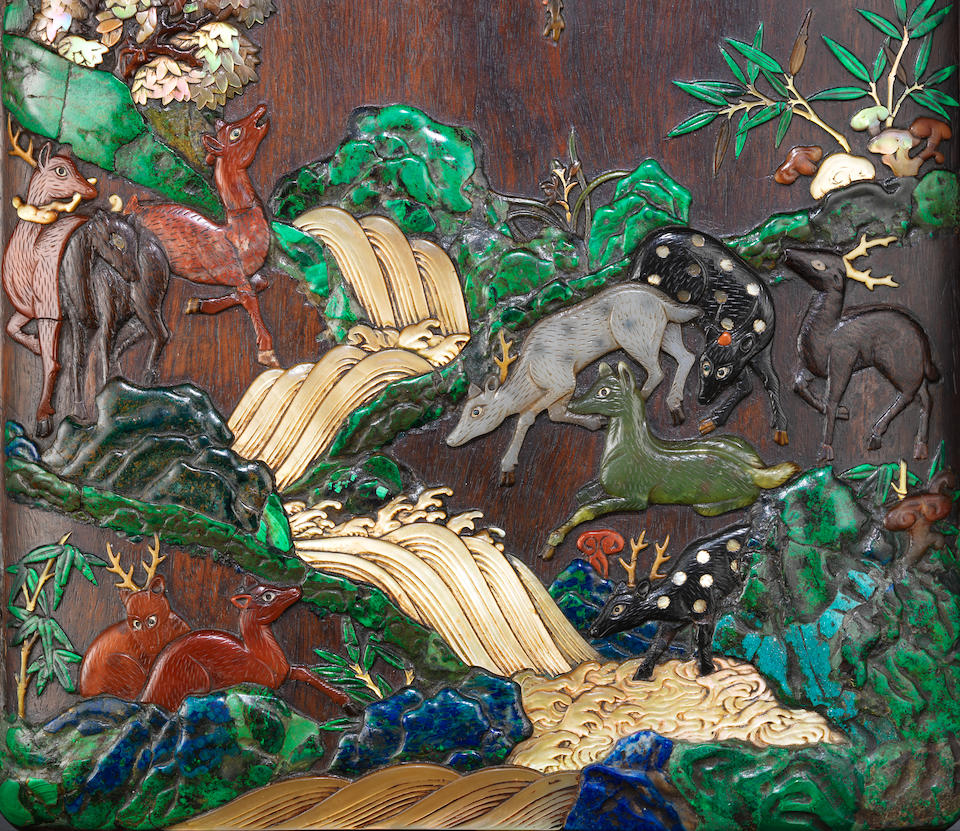

Lot 33. An exceptional finely-inlaid 'hundred deer' zitan box and cover, Kangxi period (1662-1722); 28.5cm x 17.8cm (11in x 7in). Estimate HK$ 3,500,000 - 4,500,000 (€410,000 - 530,000). Sold for HK$ 8,440,000 (€ 1,002,720). Photo Bonhams
The cover skilfully embellished with delicate colourful sheets of inlay in various vivid media including mother-of-pearl, malachite, nephrite, soapstone, gilt-bronze, carnelian, and carved wood, depicting a herd of dotted and striped deer gambolling and resting in a lush landscape encircled by fast-flowing and swirling streams cascading from jagged rocks amidst wutong, bamboo,lingzhi and narcissus, below a gnarled pine branch with overhanging wutong branches growing from the top of the cliff, all under a red lacquered sun partially obscured by clouds, all inlaid on the zitan ground, the rim of the cover and box finely inlaid in silver wire to form a key-fret border, the wood of attractive reddish-brown tone with characteristic streaks, the box raised on four bracket feet, fitted box.
Provenance Sotheby's Hong Kong, 17 May 1989, lot 348
Published and Illustrated Sotheby's Hong Kong Twenty Years, Hong Kong, 1993, p.260, pl.407
Sotheby's Thirty Years in Hong Kong, Hong Kong, 2003, p.347, pl.407
Note: This exquisite box and cover belongs to a group of inlaid objects typically applied on precious zitan or huanghualiwood. This inlay technique is often referred to as Baibao qian or 'One Hundred Precious Objects Inlay'. The term is derived from the multiple and diverse materials used in creating the decoration, including jade, agate, malachite, soapstone, carnelian, mother-of-pearl, tortoiseshell and lacquer. The use of such a wide variety of materials to compose a pictorial scene, results in a stunning effect of vibrant colours and different textures, which as demonstrated by the present lot, accomplishes great complexity and depth. Works of art made employing this technique required the sourcing of expensive semi-precious materials as well as the prized zitan wood; combined with the masterful craftsmanship that would have been required, such objects would have been very costly to produce.
This technique was used to a great effect during the late Ming dynasty, as demonstrated in a number of inlaid zitanand huanghuali wood boxes from the Qing Court collection, illustrated in The Complete Collection of Treasures of the Palace Museum: Bamboo, Wood, Ivory and Rhinoceros Horn Carvings, Hong Kong, 2002, pls.219-225, with some works in this style associated with the renowned master carver Zhou Zhu.
For early Qing dynasty examples from the Palace Museum, Beijing, compare an inlaid zitan box and cover, of similar rectangular form with decoration featuring a hunting scene, also with silver wire inlay around the rims, but rendered in a slightly different key-fret band; and see an inlaid zitan tiered picnic box and cover, with a design of egrets amidst lotus and very similarly designed silver-wire inlay key-fret bands to the rims, from the Qing Court collection, illustratedibid., pls.226 and 230.
The present example, in its outstanding decoration of deer within a landscape, reflects the highest level of workmanship achieved during the early Qing dynasty. The brilliance of the master craftsman is evident in how naturalistic the scene appears. Consider how the flowing river with splashing waves is rendered with a wonderful sense of movement, or how elegant the vines and leaves trailing from the gnarled pine branches are. Remarkably, despite each component being carefully carved separately and then assembled together to form the scene, inlaid decoration during the Kangxi period illustrates a distinctively free and elegant quality. The individually carved deer are also exceptional, each in different poses, detailed with carefully incised fur and expressive eyes.
The multiple deer depicted on the present box elude to the popular 'hundred deer' motif, bailu, which is a homophone for 'hundred emoluments', representing the wish 'May you receive the hundred emoluments from heaven'. Deer were also regarded as symbols of longevity due to their long life spans and ability to find lingzhi, the fungus of immortality. The decoration on the present box, with deer depicted together with pine trees and rocks that are also symbols of longevity, presents a multitude of auspicious wishes.
A further vestige of the Imperial Qing Court is a rare Imperial gilt-bronze archaistic ritual bell, Qianlong mark and of the period, dated to the 10th year, corresponding to 1745, estimated at HK$ 1,200,000 – 1,500,000. The bells were required by Court protocol for ritual ceremonies and important occasions, including state rituals, Court assemblies, formal banquets and processions of the Imperial Guard. Extremely heavy and expensive to cast, these Imperial musical instruments formed an important part of Court furnishings.
Lot 37. A rare Imperial gilt-bronze archaistic ritual bell, bianzhong, Qianlong mark and of the period, dated to the 10th year, corresponding to AD 1745. Estimate HK$ 1,200,000-1,500,000 (€140,000 - 180,000). Sold for HK$ 1,480,000 (€ 175,832). Photo Bonhams
Heavily cast with rounded sides and suspended from a gilt handle formed by geometric scrolls, the body decorated in relief with five alternating bands of stylised trigrams and spiralling bosses, interrupted on each side by a rectangular panel, each enclosing an inscribed tablet bordered by ruyi-head scrolls and above a small waisted lotus base, one tablet inscribed with a seven-character mark, 大清乾隆拾年製, 'made in the 10th year of the Qianlong emperor's reign', the other with a two-character mark, 夾鐘 jia zhong , which relates to a classical pitch, the lower body above the base with pairs of archaistic motifs flanking two large plain circular cartouches, later wood stand. 29.6cm (11 5/8in) high (2).
Provenance A European private collection
Note: The present lot belongs to a group of bells, which were assembled in sets of sixteen, suspended on wooden frames in two tiers of eight. Together, the bells provided twelve musical tones with four repeated notes in lower or higher octaves. The present bell's inscription, 夾鐘 jia zhong, corresponds to the modern musical scale minor third or E/D-sharp(#); see Z.Wu and K.Taylor-Wu, Heavenly Stems and Earthly Branches Tiangan Dizhi, The Heart of Chinese Wisdom Traditions, London, 2014, p.118. Unlike archaic bronze bells from the Shang dynasty, these Qing period instruments created different pitches and notes by the varying thickness of the bell's walls rather than their sizes.
The bianzhong were required by court protocol for ritual ceremonies and important occasions, including state rituals, court assemblies, formal banquets and processions of the imperial guard. Extremely heavy and expensive to cast, these imperial musical instruments formed an important part of court furnishings. In 1741, the Qianlong emperor set up a music division for court music and chose melodies for specific court functions, see W.Yi and H.Haitao, Qingdai gongting yinyue [Palace Music of the Qing Dynasty], Beijing, 1985, p.13.
It is rare to find Qianlong bells of this particular shape and cast with decoration of trigrams and spiralling bosses, which are more typical of the Kangxi reign. A very similar bell, also dated to the 10th year of Qianlong's reign but inscribed with 南呂nan lü, is in the Metropolitan Museum of Art, New York, gifted by Major Louis Livingston Seaman in 1903, museum no.03.15.3. Compare a full set of sixteen bells, Qianlong, dated to 1779, on a wooden frame, similarly cast with bands of trigrams and bosses but with different handles and more plain circular roundels around the lower body, in the Palace Museum, Beijing, illustrated by C.Ho and B.Bronson, Splendors of China's Forbidden City: The Glorious Reign of Emperor Qianlong, Chicago, 2004, p.52, no.43.
A very similar bell also dated to the 10th year of Qianlong's reign but inscribed with bei yi ze, sold at Christie's New York, 21 March 2000, lot 167; see also a related bell, dated to the 52nd year of the Kangxi emperor, sold at Sotheby's Hong Kong, 9 October 2007, lot 1327.
A rare white jade double-sided screen, Qianlong (1736-1795), estimated at HK$ 600,000 – 800,000, is a particularly opulent and skillfully carved example, utilising the precious white jade stone as a pictorial canvas.
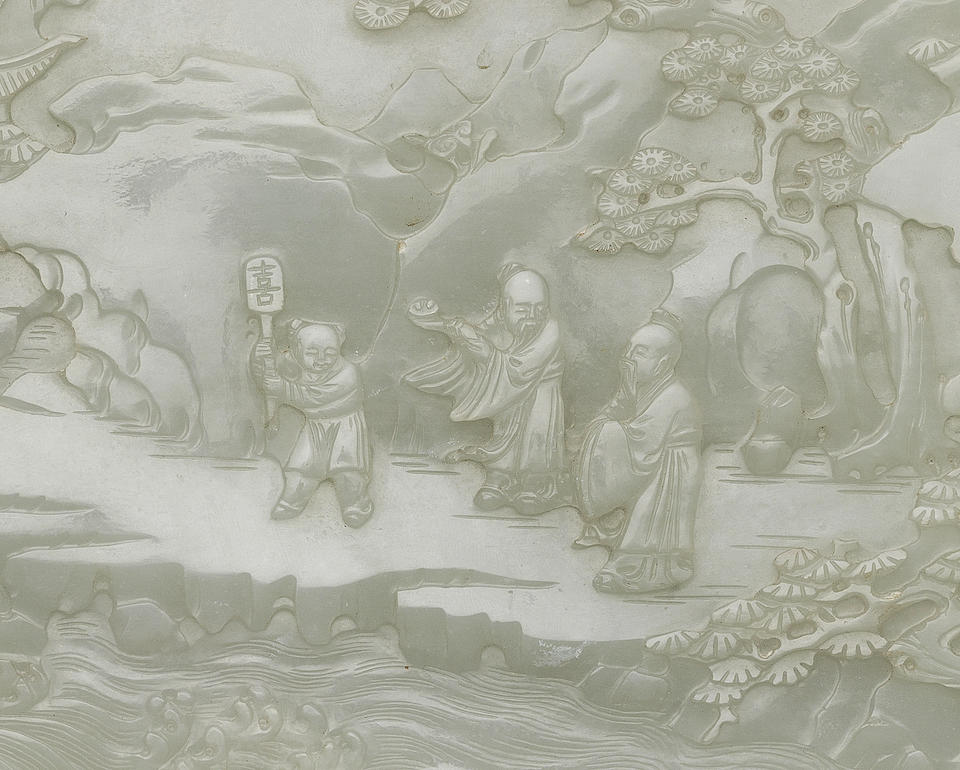
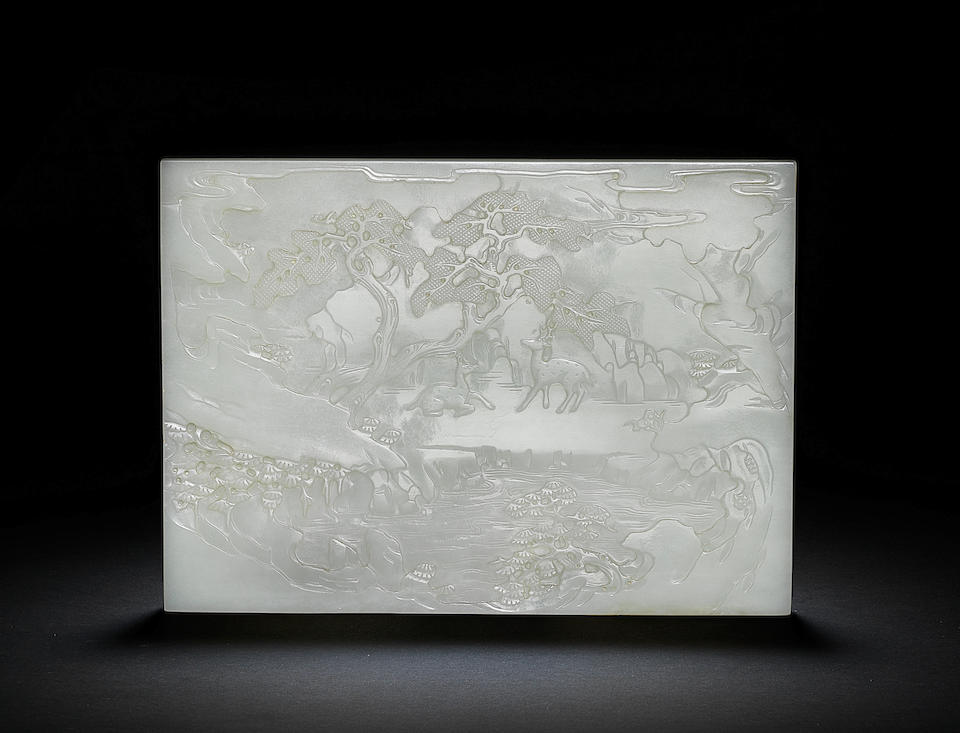
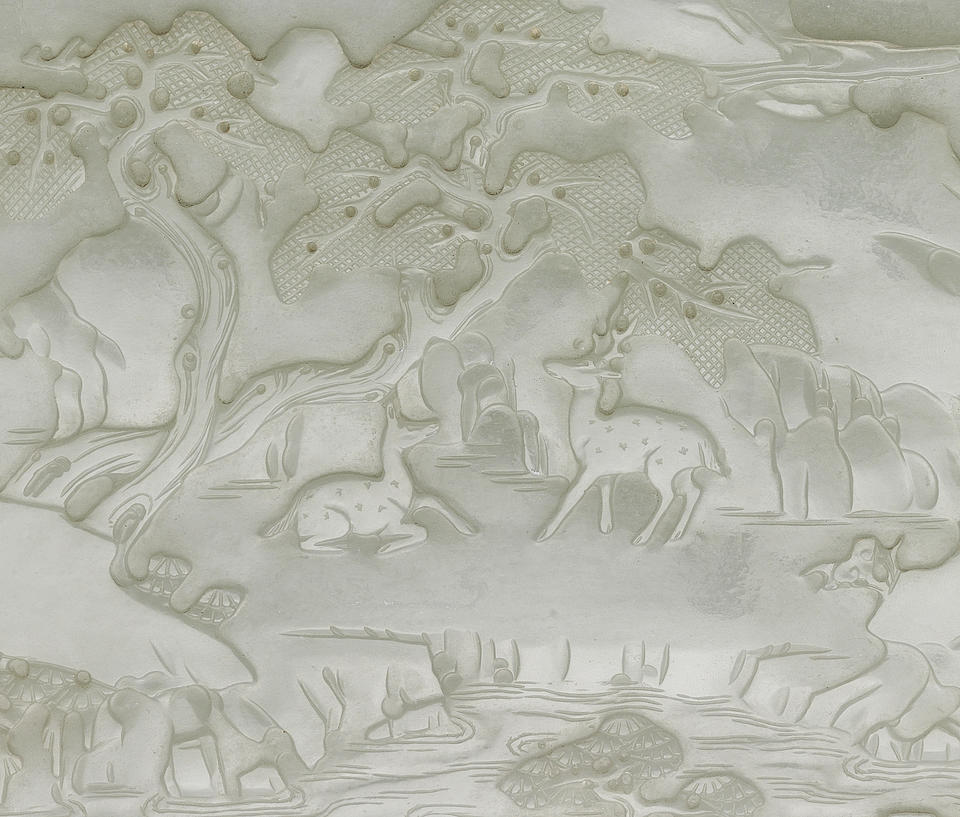
Lot 41. A rare white jade double-sided screen, Qianlong period (1736-1795); 23.5cm x 17cm (9 1/4in x 6 3/4in). Estimate HK$ 600,000 - 800,000 (€70,000 - 94,000). Sold for HK$ 1,240,000 (€ 147,324). Photo Bonhams
Skilfully carved in varying relief depicting two sages walking towards a pavilion, accompanied by an attendant holding a banner inscribed with the characterxi, all set within a mountainous landscape detailed with pine and wutong trees and a fast-flowing stream, the reverse carved with a stag and a doe in a similar setting, the attractive stone of an even white tone, wood stand.
Provenance An English private collection, by repute acquired from John Sparks Ltd., London, circa 1960-70s
Note: The Qianlong emperor's appreciation of jade landscape screens is demonstrated in one of his poems, as discussed in an essay by Yang Boda, 'Jade: Emperor Ch'ien Lung's Collection in the Palace Museum, Peking', Arts of Asia, March-April 1992, which may be translated as follows:
'This piece of precious jade slab is from Khotan. It is unsuitable for making vessels such as the dragon hu and animallei. In order to fully utilise it, it is carved into a panel with the scene of "A Riverside City on a Spring Morning". Imagination is exerted to turn the natural undulation or ruggedness into an appropriate landscape... It takes ten days to carve with a tiny bit of water and five days to shape a piece of rock. The crafting is indeed very time-consuming.'
In utilising jade for screens, the master carvers turned this prized medium into a pictorial canvas. The opulence of the jade screen is particularly noteworthy considering the quality of the white jade stone.
See a related pale green jade screen, Qing dynasty, carved with three sages in a similar landscape scene with a lone pagoda, from the National Palace Museum, Taipei, illustrated by Chang Li-tuan, The Refined Taste of the Emperor: Special Exhibition of Archaic and Pictorial Jades of the Ch'ing Court, Taipei, 1997, pl.71; compare also a related white jade horizontal rectangular 'landscape' screen, Qing dynasty, from the Qing Court collection, illustrated in The Complete Collection of Treasures of the Palace Museum: Small Refined Articles of the Study, Shanghai, 2009, pl.231.
Beautifully worked on both sides of the screen, the present lot also conveys a multitude of auspicious blessings. The young attendant holds a banner with the character xi, meaning happiness, and one sage holds a ruyi sceptre which signifies the fulfilment of all wishes. The reverse with deer amidst cypress trees, expresses the wish 'bailing shilu' or 'May you attain old age and continue to receive emolument'. The depiction of cypress trees on jade screens are quite rare; see, however, a white jade table screen, carved with the Nine Elders of Xiangshan within a mountainous landscape detailed with a pine and cypress tree, Qianlong, illustrated in The Splendour of Jade, The Songzhutang Collection of Jade, Hong Kong, 2011, pp.172-173, no.140.
An exceptional Chinese ormolu paste-set clock, Qianlong (1736-1795), Guangzhou workshops, is estimated at HK$ 800,000 – 1,200,000. Timepieces provided a bridge between Western and Chinese culture, with the European Jesuits utilising the sophisticated and exotic clocks as a means to gain access to the Imperial Court. The passion for European clocks was embraced by the Qing Court and the Qianlong Emperor, but also extended to imminent officials and wealthy merchants. Clocks were symbolic of the ability to master the time and the calendar; they solidified the Emperor's position as the Son of Heaven of having divine powers and the ability to control the transcendence of time in the universe. They also represented the relationship between time and good governance.

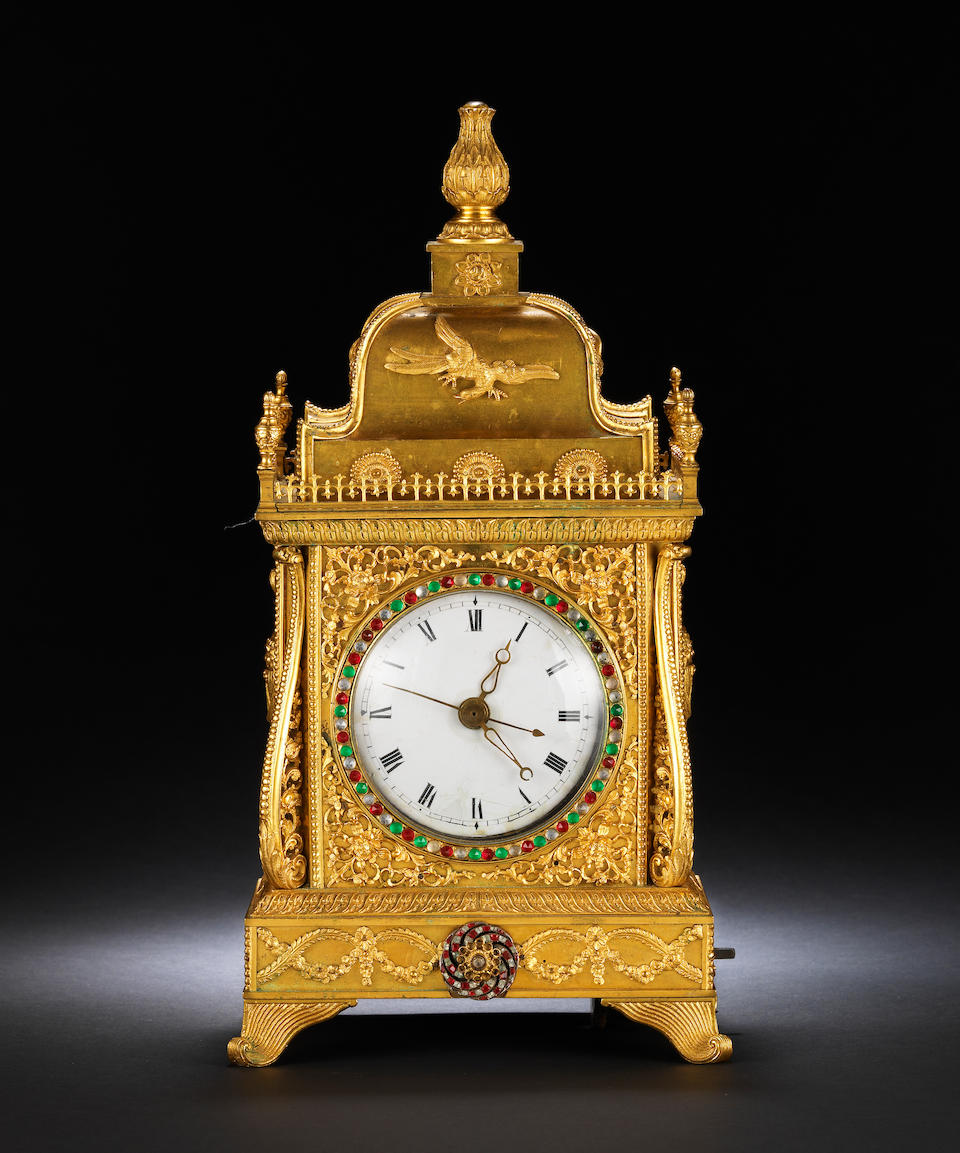
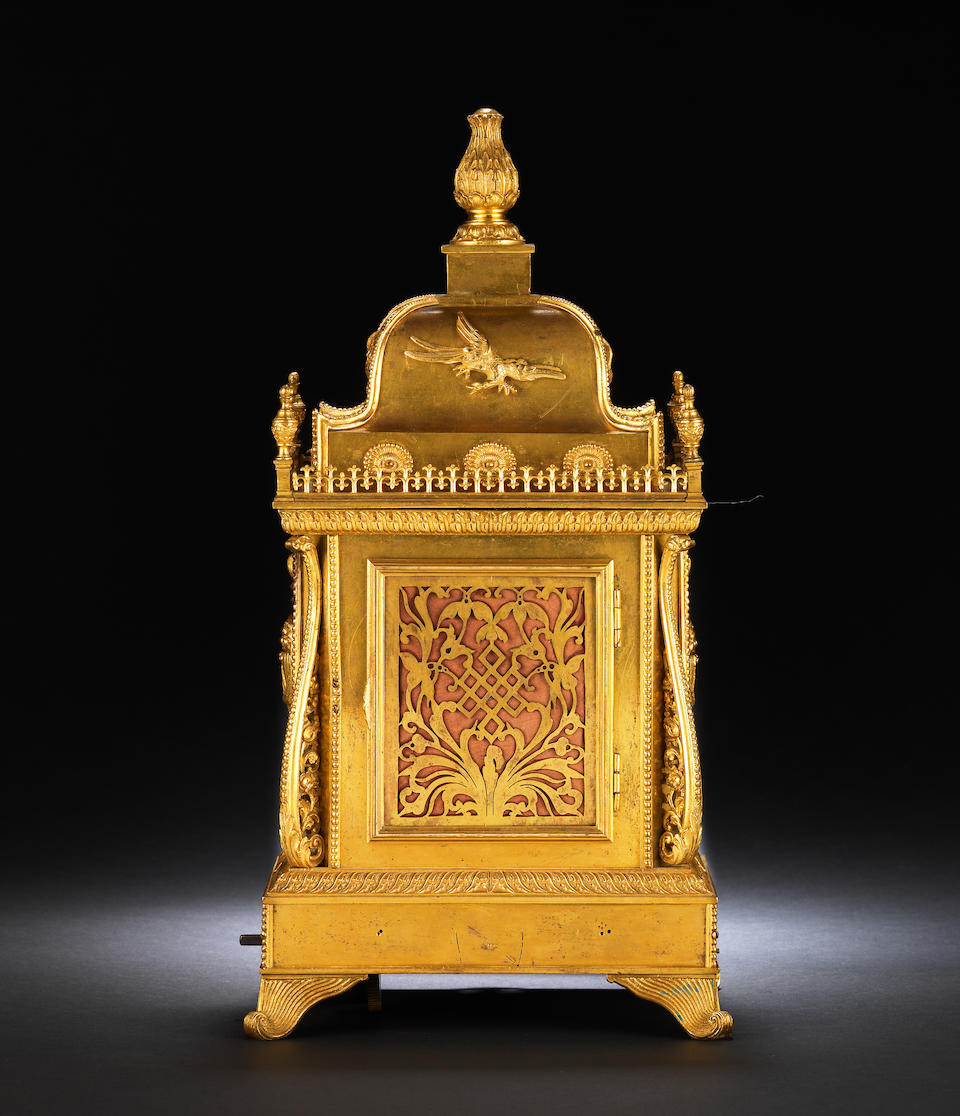
Lot 36. An exceptional Chinese ormolu paste-set clock, Qianlong, Guangzhou workshops. Estimate HK$ 800,000 - 1.2 million (€94,000 - 140,000). Unsold. Photo Bonhams
The case surmounted by a cast bud finial on an shaped caddy set with mounts of flying Vermilion Birds zhuqueand ten oval medallions, framed by a pierced balustrade and set to each corner with a flaming urn finial, the main body applied with a pair of urn mounts between pierced scroll corner supports, on a plinth base with reeded bracket feet, the rear set with a cast door frame enclosing a pierced silk-backed sound fret depicting flowers and trellis in silhouette, the 3.75 inch enamel Roman dial with outer minute band and brass hands, framed by a bezel set with red, green and transparent brilliants, the twin fusée movement wound from the rear with knife-edge verge escapement striking on a bell, the backplate decorated by engraved bands to the edge, the case further set with a separate spring-driven movement in the base, wound from the side and activating the rotating stone-set medallion to the front on command via a slider set to the side. 36cm (14 1/8in) high
Provenance A European private collection
Note: Timepieces provided a bridge between Western and Chinese culture, with the European Jesuits utilising the sophisticated and exotic clocks as means to gain access to the imperial court. The first to initiate this was the Jesuit priest Matteo Ricci, who presented two chime clocks to the court of the Wanli emperor in 1601, and the same means were used also during the 18th century, from the Kangxi reign onwards. The passion for European clocks was embraced by the Qing court and the Qianlong emperor, but also extended to imminent officials and wealthy merchants.
Clocks were symbolic of the ability to master the time and the calendar; they solidified the emperor's position as the Son of Heaven of having divine powers and the ability to control the transcendence of time in the universe. They also represented the relationship between time and good governance, as demonstrated in a poem composed by the Kangxi emperor titled 'The Chanting of the Chiming Clock', which translates as:
'Methods originating from the West, taught us with a keen heart.
Wheels circle on a quarterly basis, hands move according to minutes.
Dawn needs not to be announced, golden clock reports in advance.
Work hard on government affairs in the morning, memorials are never completed in a late manner.'
The Qianlong emperor inherited from his grandfather his passion for science and clocks. The imperial court indulged in luxuries including extravagant mechanical amusements. The emperor not only had many clocks imported from Europe, but specifically ordered by decree for both his Chinese and European clockmakers from the imperial workshops to create and replicate these timepieces. These skilled artisans were given priority access to an assortment of expensive raw materials, including gold, jade, lacquer, ivory, gemstones and zitan. References to the imperial workshops making timepieces were found dating back to 1723, where production began during the Yongzheng period. It is also recorded that there were once as many as 3,431 timepieces on display within the imperial palace at one time by imperial command; see Moments of Eternity: Timepieces Collection from the Palace Museum, Macao, 2004, pp.448-449.
Sophisticated timepieces whilst initially brought from Europe, were subsequently produced and re-interpreted in their decorative motifs, by local workshops in Guangzhou, Yangzhou and Beijing. In addition to the Beijing imperial workshops, fine clocks made in Guangzhou were also presented to the emperor as imperial tribute, demonstrating the outstanding level of craftsmanship achieved by the Chinese clocksmiths, as well as their familiarity with European and in this case English clocks of the late 18th century.
It is not surprising that the present clock was made after an English prototype, such as the one from the Nezu Museum, Tokyo, sold at Christie's Hong Kong, 27 May 2008, lot 1515, as China became Britain's chief export market for its timepieces in the 18th century.
Compare a related clock in the Palace Museum, Beijing, illustrated by Lu Yangzhen, Timepieces Collected by the Qing Emperors in the Palace Museum, Hong Kong, 1995, p.170; see also another example from the Qing Court collection with similar form and feet but with a lacquered wooden body, illustrated in Moments of Eternity: Timepieces Collection from the Palace Museum, Macao, 2004, p.297, pl.107.
A related ormolu and paste-set striking and musical clock, Qianlong, was sold at Sotheby's Hong Kong, 9 October 2012, lot 3021.
Asaph Hyman, Bonhams International Head, Chinese Ceramics and Works of Art, commented: "We are delighted to offer a fine selection drawn upon many distinguished European collections, of Imperial porcelain and outstanding works of art."

/https%3A%2F%2Fprofilepics.canalblog.com%2Fprofilepics%2F1%2F0%2F100183.jpg)
/https%3A%2F%2Fstorage.canalblog.com%2F03%2F02%2F119589%2F96711876_o.jpg)
/https%3A%2F%2Fstorage.canalblog.com%2F11%2F31%2F119589%2F94773502_o.jpg)
/https%3A%2F%2Fstorage.canalblog.com%2F20%2F83%2F119589%2F94772815_o.jpg)
/https%3A%2F%2Fstorage.canalblog.com%2F26%2F72%2F119589%2F75604929_o.jpg)
/https%3A%2F%2Fstorage.canalblog.com%2F59%2F60%2F119589%2F26458628_o.jpg)






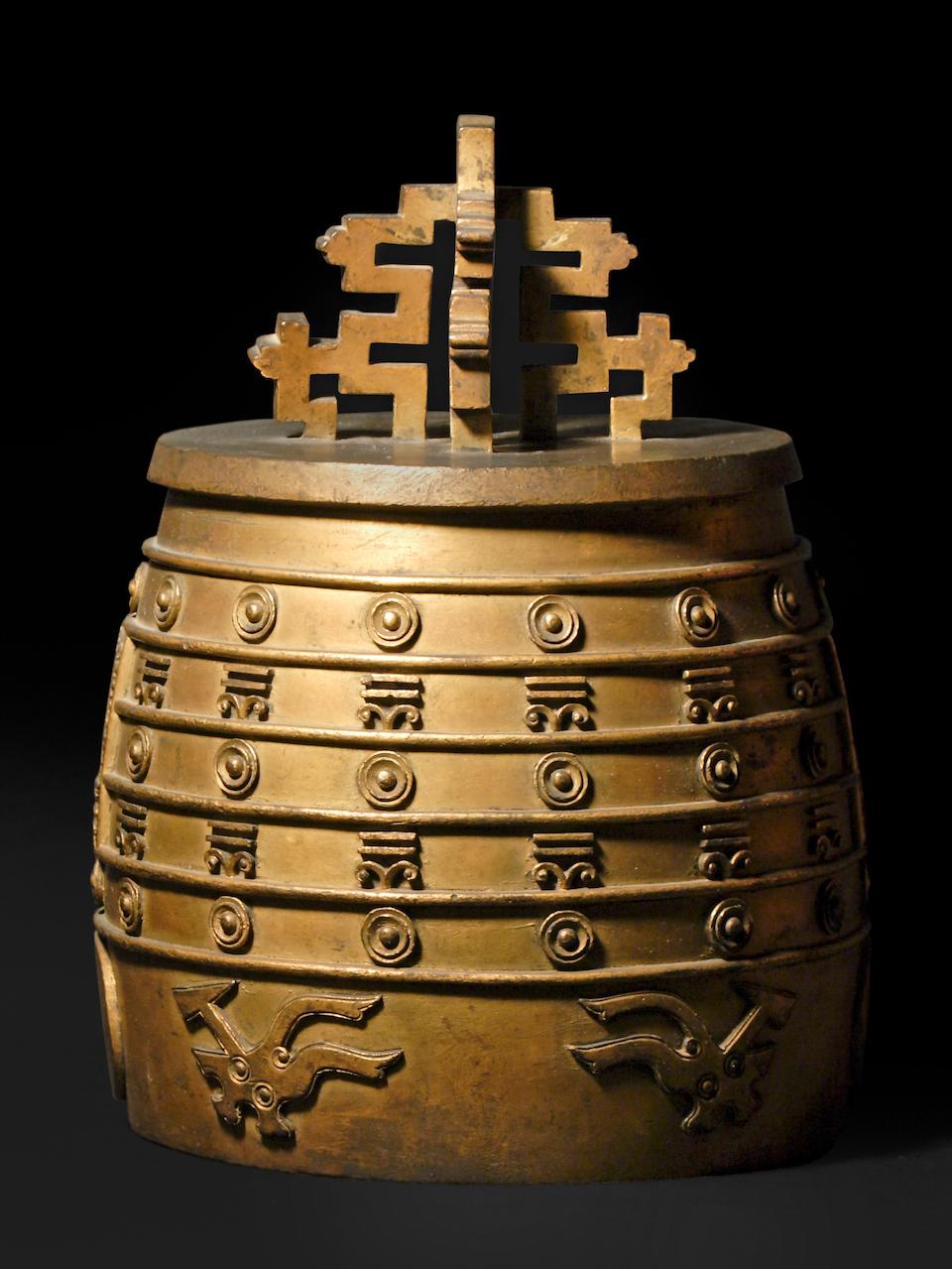
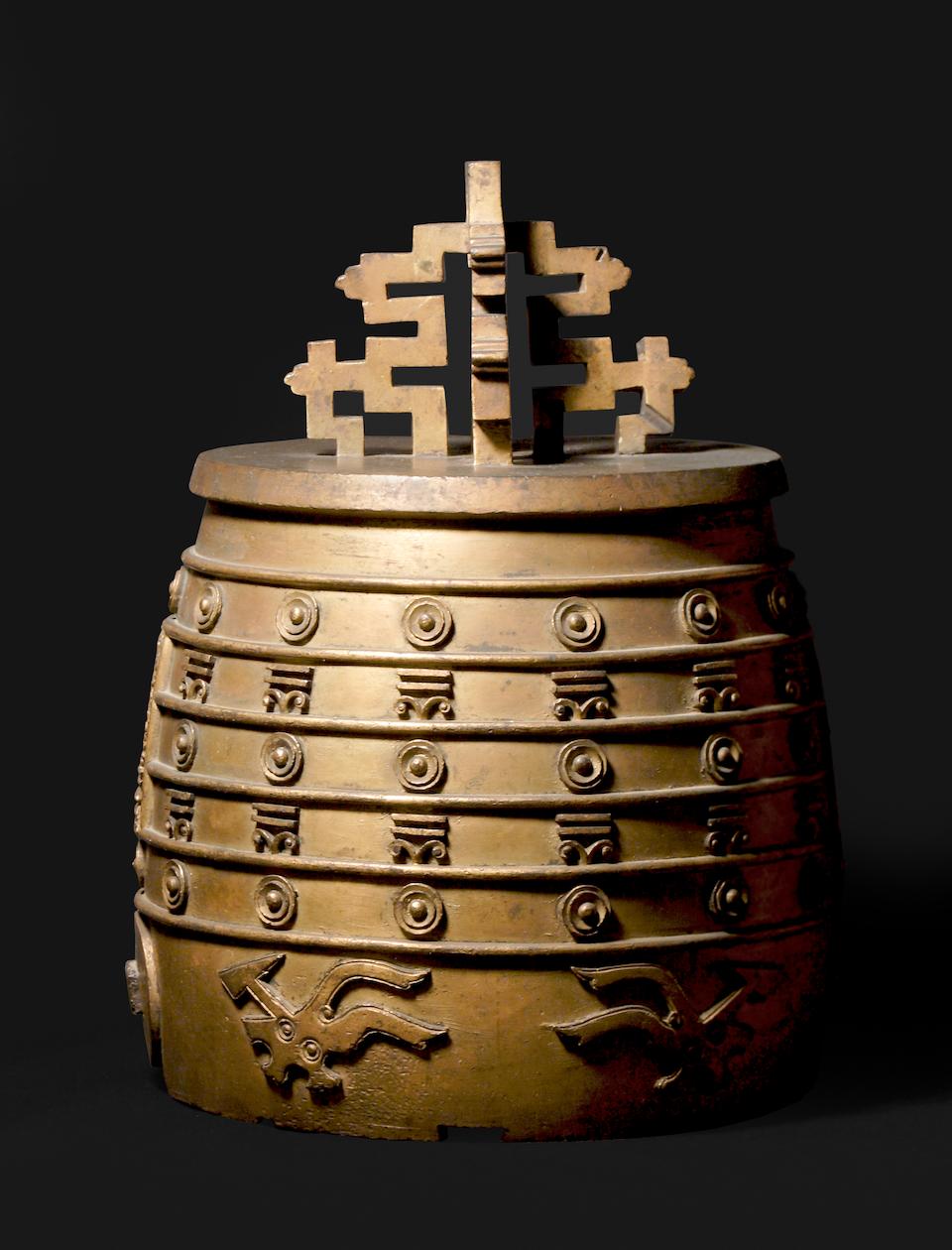
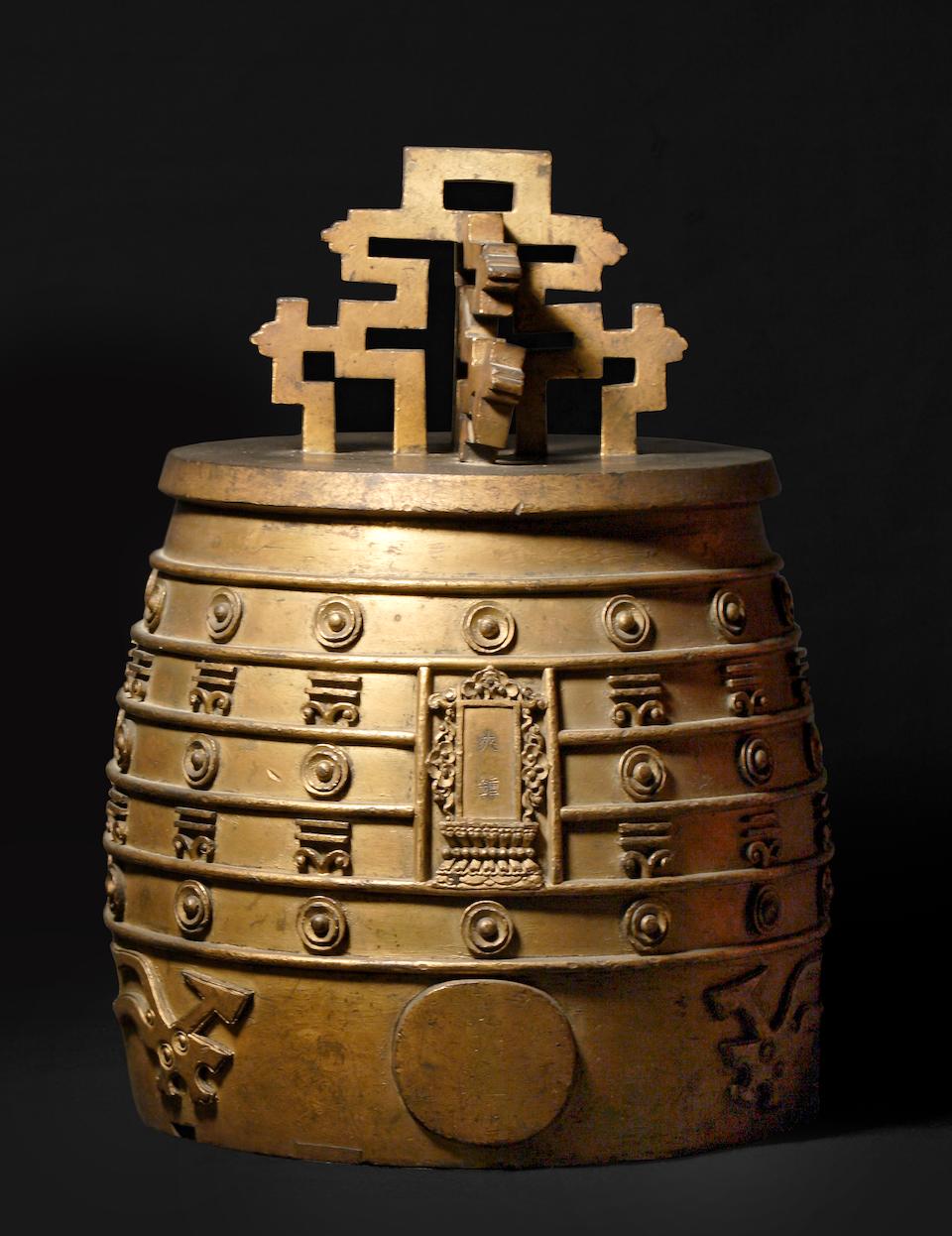
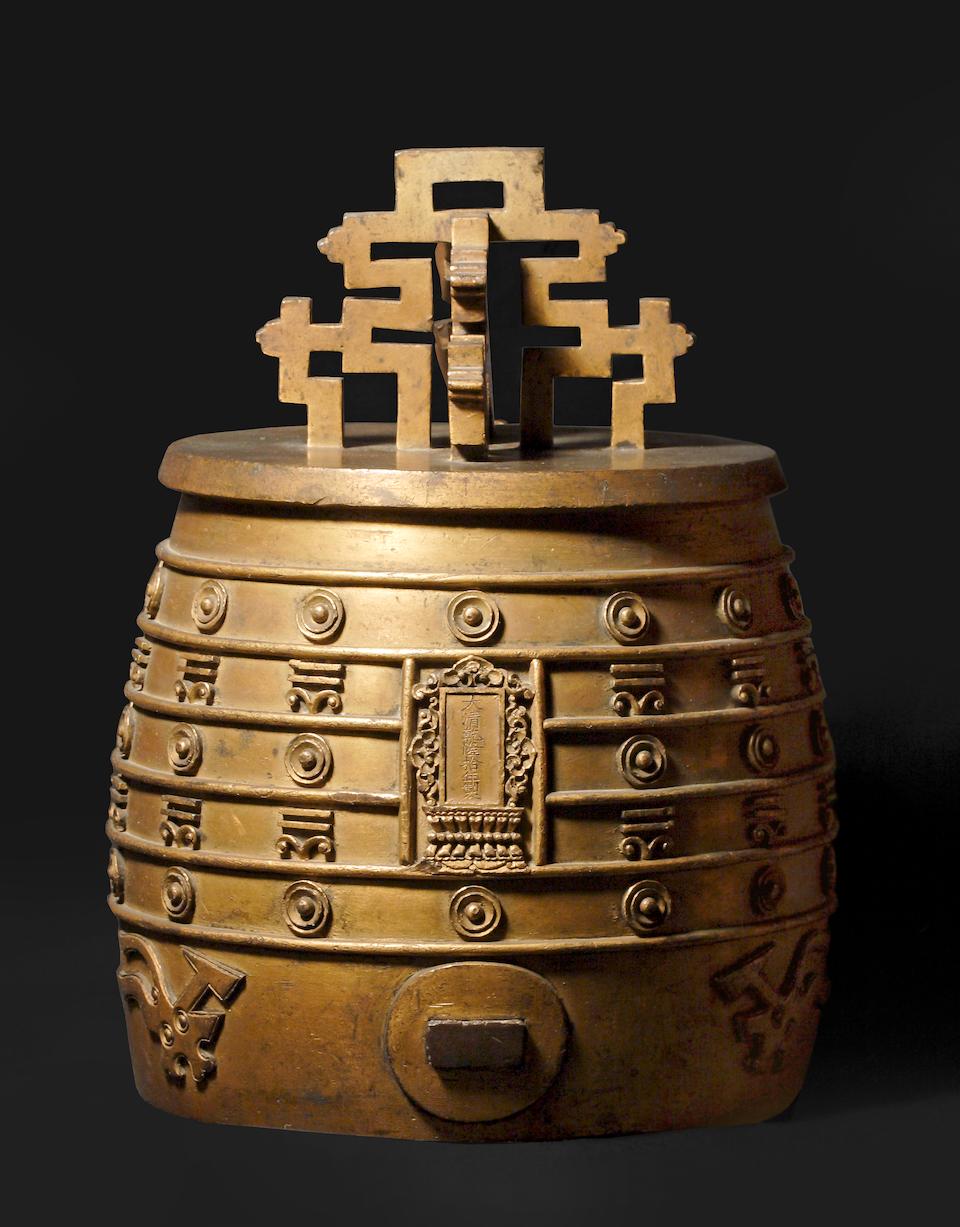



/image%2F1371349%2F20240402%2Fob_f03735_865-1.jpg)
/http%3A%2F%2Fstorage.canalblog.com%2F23%2F87%2F119589%2F114067753_o.jpg)
/http%3A%2F%2Fstorage.canalblog.com%2F10%2F70%2F119589%2F113057358_o.jpg)
/http%3A%2F%2Fstorage.canalblog.com%2F72%2F36%2F119589%2F113056850_o.jpg)